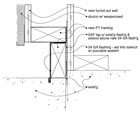
The international codes and state codes require sidings over framed walls to be held up off the final grade or hard surface to facilitate drainage of incidental moisture that may find its way behind the cladding. It is also true that there are many projects, commercial and residential, where the siding is brought down to grade and/or the concrete flat work is poured up and over the exterior siding. There is no doubt this is a code violation and can create liability for both the general contractor and the subcontractors. In most cases it is just overlooked and is a code violation, frequently resulting in litigation on multi-family projects. In other projects it may result in eventual rot of the siding or underlying wood and/or gypsum products.

LETTER VS. INTENT
Many designers and building owners do not want to see that large gap between the siding and the grade or concrete flat work. In new construction, you should point out the problem to the general contractor and/or architect. The code requires installers to maintain a clearance of 4 inches off earth and 2 inches off paved surfaces (IRC Section R703.6.2.1).If a designer or general contractor directs you to install exterior siding that may violate the code, you should bring up the concern in writing to protect yourself. The letter should not be confrontational, just noting the concern, pointing to the appropriate code section(s) and asking for direction on how to proceed. After all, the architect may have an alternate design that has been approved by the building department. This would now be code-legal. For example, the architectural firm I worked for frequently ran into conditions where the exterior siding and concrete flatwork conditions did not meet code. To meet the letter of the code may not always be possible. We frequently use an alternate design that we believe meets the intent of the code. We have been successful on several occasions presenting the building officials with the alternate design that did not meet the code to the letter, but the intent of the code was achieved, and thus approved.
There are other industry-recognized details that do not exactly meet the language in the code. However, they do meet the intent of the code and would be accepted by most building officials, provided they meet sound engineering principles and accomplish the intent of that section of the code. A word of caution, the argument “that’s the way I have done it for years” will not wash with the building department or construction experts in litigation.
Know the code as it relates to your business. Any directions given to you that violate the code should be done in writing, or you should send a letter expressing concern and your willingness to proceed as directed.






